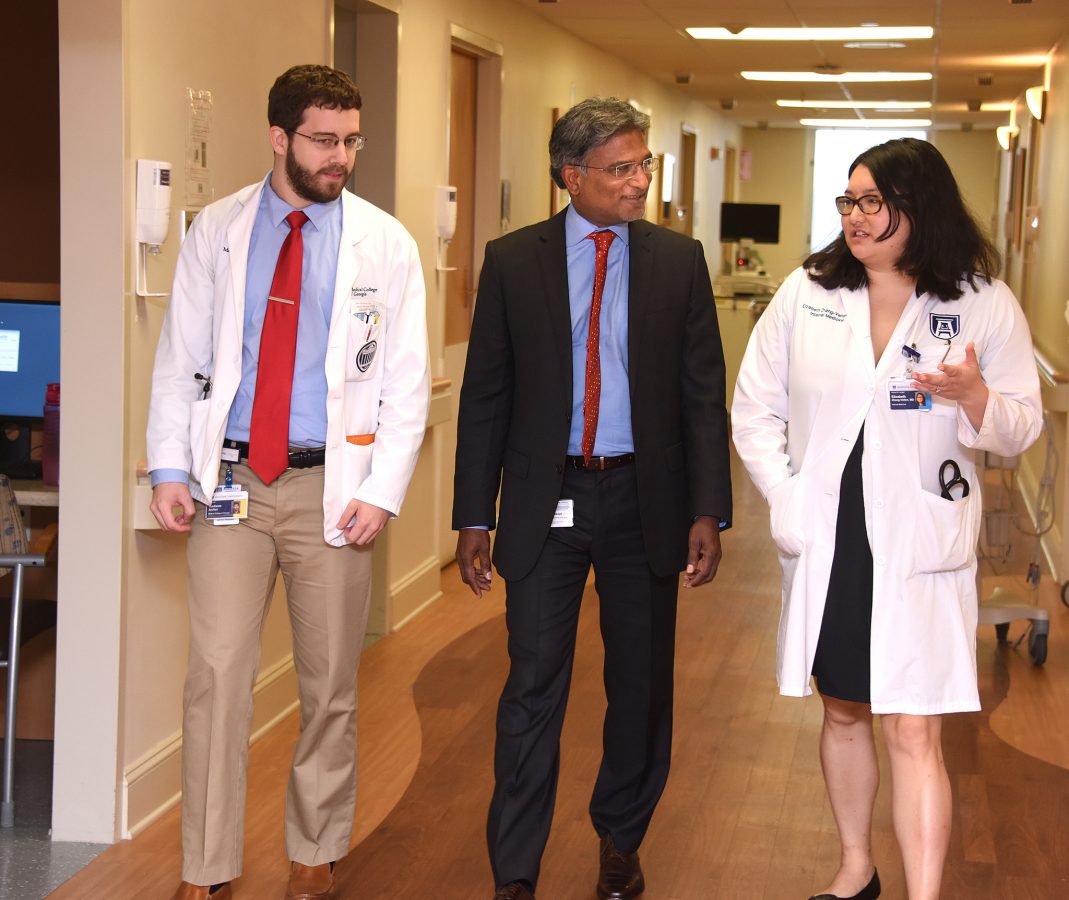A national cooperative group trial is making a handful of the country’s experts in a rare leukemia available around the clock, with the goal of cutting by more than half the high mortality rates that occur in the difficult first few weeks of treatment.
Induction mortality for treatment of acute promyelocytic leukemia, or APL, can be as high as 30 percent, but for patients who survive those first few weeks, survival rates can soar beyond 90 percent, making it the most- curable leukemia.
“The most frustrating problem in APL is what we call early deaths,” says the National Cancer Institute-supported cooperative’s study chair and principal investigator Dr. Anand P. Jillella. Jillella is chief of the Division of Hematology/Oncology at the Medical College of Georgia and associate director of medical oncology services at the Georgia Cancer Center at Augusta University.
“Those rates have not changed in the last two decades despite having blockbuster drugs to treat patients. We want to help and we want physicians to call us any time if they have an APL patient,” he says.
Jillella and Dr. Vamsi Kota, an assistant professor in the Department of Hematology and Medical Oncology at Emory University School of Medicine and Emory’s Winship Cancer Institute, have developed a checklist they share with those physicians that labels APL a medical emergency and covers early, major concerns with the cancer and its treatment.
Experience with the strategy in about 160 patients in Georgia and South Carolina has decreased induction mortality from an estimated 30% to 6.7%.
“These are the tests you do when you diagnose APL, this is how you manage bleeding, this is how you manage complications to the drugs, this is how you manage infections,” Jillella says, running down the checklist.
“It’s a rare disease so it’s not easy for patients or physicians to recognize the complications of the disease early,” Kota says of their newly expanded effort to lend a national hand to colleagues and measure the impact.
They estimate about 3,000 APL patients are treated annually by the nation’s 15,000 hematologists/oncologists. That math alone means most specialists don’t see many, if any, APL patients in their careers. In fact, it was Jillella’s own early experience with more patients dying than clinical trials data prepared him to anticipate that led to the now national initiative. U.S. based trials had largely reported survival rates in the 90s.
“We got involved because we wanted other physicians to feel free to call us to discuss how to manage their patients,” says Kota, who worked with Jillella while completing his residency and fellowship at MCG, followed by three years on faculty.
“Even relatively small things in treatment can make very dangerous things happen,” Kota says. That means, for example, keeping a super-close eye on fluid retention and weight as patients receive intravenous fluids and blood products, which prevent some APL complications, but in excess can quickly cause respiratory problems that require intensive care.
They plan to enroll about 200 patients over four years in the NCI national cooperative. The six lead centers include MCG; Mayo Clinic Jacksonville and Rochester; Memorial Sloan Kettering in New York; Northwestern University in Chicago; and the University of Pennsylvania in Philadelphia. They expect that approximately 70 percent of patients will come from some 40 sites for the National Community Oncology Research Program, an NCI-initiative to make cancer clinical trials more widely available.
APL is a type of acute myeloid leukemia in which white blood cells that normally help protect us from infection inexplicably get stuck in an early, dysfunctional state of development that instead clogs the bone marrow. Production of these and other cell types is a constant in our bone marrow that APL disrupts.
Patients can quickly become anemic, have problems with blood clotting and bleeding and be vulnerable to infection. “You feel tired because you are not making blood. It totally deranges the way blood clots so you bruise and bleed easily. The worst thing that can happen is patients experience a bleed in their brain,” Jillella says.
Early intervention with analogues of vitamin A or arsenic can help restore more normal differentiation of needed white blood cells within just a few days. Patients may also receive chemotherapy and blood products and all treatments need rapid initiation.
In a decade of work with these patients, Jillella and Kota found that their three main causes of death were bleeding, infection and complications from the treatment. They also realized that with a wide age range of disease onset from 20 to 80, drug doses needed to be modified based on age. Their findings are reflected in the treatment approach they now bring to patients.
Their national model mirrors Jillella’s and Kota’s work with more than 30 leukemia practices throughout Georgia and South Carolina in a program funded by the Leukemia & Lymphoma Society since 2013. He and Kota shared their contact info with physicians at those sites and said to feel free to call them any time they received a patient with APL. That effort has now enrolled more than 160 patients with about an 89 percent survival rate. Jillella notes that better than half the patients were treated in more rural areas.
Relapse rates for APL are a low 2-3 percent. Jillella and Kota are developing plans to utilize the existing network to offer similar supportive services for a handful of other rare cancers.
 Augusta University
Augusta University




